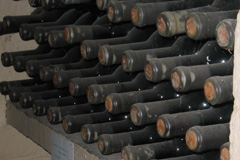How do you know when a bottle of wine is ready to drink?
By John ~ April 23rd, 2010.
 First of all, let’s get right to the obvious. If a wine costs less than $10, has a screwcap closure, or comes in a box, it is ready to drink now. Today, the overwhelming majority of wines, even at higher price points, are made to be drunk young. So enjoy! Many more wines are drunk too late than too early.
First of all, let’s get right to the obvious. If a wine costs less than $10, has a screwcap closure, or comes in a box, it is ready to drink now. Today, the overwhelming majority of wines, even at higher price points, are made to be drunk young. So enjoy! Many more wines are drunk too late than too early.
To improve over time, a wine must develop complexity to offset the inevitable loss of fruit flavors as it ages. Typically, these wines are more expensive, so price is a clue that you might need to be a little patient before you consume a wine. Harsh tannins are another clue that a wine needs some aging. If you open a bottle today, drink part of it, and then realize that it will benefit from some aging, just close it back up and open it again tomorrow and again the day after tomorrow. If it seems to be better after being opened a few days, it is a wine that will last and probably needs more aging to be at its peak. That is the value of buying more than one bottle of a wine you have reason to believe you’ll really like.
In general, top quality red wines benefit more from aging than do white wines because they stay on the skins longer than whites and therefore have more of the preservatives such as tannins; although there are exceptions such as Riesling, which is high in acidity. At a good, reputable wine shop, older vintages for sale usually indicate greater complexity and longer barrel aging rather than a vintage they have not been able to sell. Current vintages in the shop are usually more ready-to-drink fruit-forward wines.
But again, let me remind you that many more wines are drunk too late than too early. So if you are not sure when to open a bottle, just open it now and enjoy!
Filed under: General Wine Information

 Wine Peeps is an independent wine blog dedicated to helping you get the most bang for your buck in wine. We do this through blind tastings of wine from around the world and calculations of
Wine Peeps is an independent wine blog dedicated to helping you get the most bang for your buck in wine. We do this through blind tastings of wine from around the world and calculations of 











I have seen several German rieslings that major press list with drinking windows as long as a decade out that have been sealed with screw caps. What are your thoughts on the fact that screw caps are becoming much more prevalent including in wines that have traditionally been sealed with corks, and the new study that says screw caps actually may be superior for aging? (see http://www.oldbridgecellars.com/data/AWRI_10YrScrewcapTrial.pdf)
David,
I like screwcaps. If they ever figure out one that would go “pop” like a cork, they would probably take over the world. The Australians have probably done the most work on testing out long term ageing of the same wine in a screwcap vs a cork closure, and the results have been encouraging to say the least. Because a screwcap lets in almost no oxygen, you basically have a reductive vs oxidative process in the bottle, so the winemaking has to be a little different. FYI, I think glass closures have promise as well. Again, no possibility of cork taint.